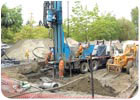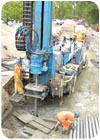
Geothermal drilling at Langara College, Vancouver, British Columbia.
Although geothermal energy still is in the early stages of technology adoption by mainstream users, today, in Canada, there are fire halls, sports complexes, ice arenas, swimming pools, civic centers, schools and entire residential communities heated and cooled by geothermal energy.
While many geothermal users tout the environmentally friendly aspect of this energy source, in reality, it often is the wallet-friendly aspect that drives most new installations.
Compared to conventional heating and cooling methods, the cost of geothermal installation isn't cheap, but the savings in energy costs over five years can more than pay for these initial up-front costs.
In most cases, consumers receive a 20 percent return on their geothermal investment and, with dire economic forecasts of high energy costs ahead (natural gas already has jumped by almost 19 percent this year), many consumers - both commercial and residential - are open-minded when it comes to alternative energy sources.
Canada has become a leader in developing geothermal as an energy choice, thanks in part to a innovative drill that uses sonic vibrations to drill faster, better and cheaper, making it perfectly suited to geothermal applications.

Despite adverse soil conditions, a single sonic rig was able to drill, case, loop and grout 23 geothermal holes in two weeks.
How the Sonic Drill Rig Works
After 27 years of field-testing and development, Ray Roussy, president of Sonic Drill Corp., Bellingham, Wash., has not only patented his high-performing drill, but also has succeeded in commercializing a rig that, depending on soil conditions, bores three times to five times faster without using any drilling mud, and is able to provide continuous core samples to depths of more than 300 feet.The Sonic Drill Corp.'s sonic drill head works by sending high-frequency, resonant vibrations down the drill string to the drill bit, while the operator controls these frequencies to suit the specific conditions of the soil/rock geology.
Resonance magnifies the amplitude of the drill bit, which fluidizes the soil particles at the bit face, allowing for fast and easy penetration through most geological formations. An internal air spring isolates these vibrational forces from the rest of the drill rig.
The resulting gain in drilling speed often has the skeptics shaking their heads disbelievingly when confronted with the evidence of a sonic rig in action.
A Case in Point
In a recent example, Roussy recounts a geothermal installation where one of his drill rigs assisted - helping to finish a library/classroom addition for the Langara community college in Vancouver, British Columbia - a project that subsequently won an award for sustainable construction.In the Langara project, three standard rigs had been working the site for nearly two months and, in that time period, they had succeeded in drilling a total of 18 holes. Under the Langara site, the soil was a diverse mixture of sand, till and gravel and littered with large boulders - daunting terrain no matter what kind of rig worked it.
Despite the soil conditions, a single sonic rig was able to drill, case, loop and grout 23 geothermal holes in two weeks flat. It was a stunning result, given that it had taken three traditional rigs nearly two months to accomplish much less.
With the well-deserved reputation of being the fastest drill in town, sonic rigs now are boring their way through Europe, Asia, North America, South America, Africa and the United Kingdom, and are being used in a variety of applications, including water well drilling, geotechnical construction, mineral exploration, environmental investigations and geothermal installations.



Report Abusive Comment